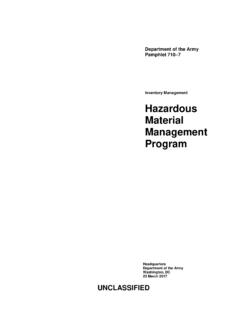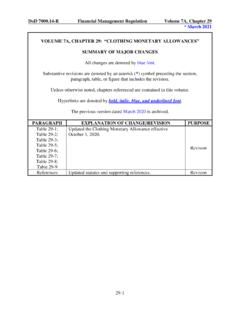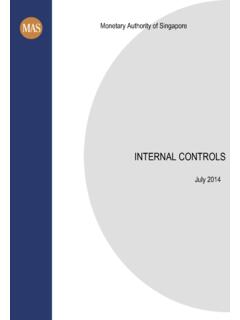Transcription of Inventory Management PDF: A Complete Guide For 2020
1 THE Complete Guide TO Inventory Management 1 Contents Chapter 1: What is Inventory Management ?2 Chapter 2: Types of Inventory11 Chapter 3: Inventory Forecasting14 Chapter 4: Purchasing Inventory20 Chapter 5: Inventory Storage26 Chapter 6: Inventory Analysis33 Chapter 7: Inventory Management Techniques41 Chapter 8: Multichannel Inventory Tracking49 Chapter 9: Inventory Accounting58 Chapter 10: Choosing An Inventory Management System64 Click Here to View This Whole Guide Online Veeqo helps retail brands provide the best experience to their customers everywhere Click here to start your 14-day free trial today, or get in touch at THE Complete Guide TO Inventory Management 2 Chapter 1: What is Inventory Management ? Read this chapter online here Inventory Management is the process of ordering, handling, storing, and using a company s non-capitalized assets - AKA its Inventory . For some businesses, this involves raw materials and components, while others may only deal with finished stock items ready for sale.
2 Either way, Inventory Management all comes down to balance - having the right amount of stock, in the right place , at the right time . And this Guide will help you achieve just that. Retail Inventory Management Retail is the general term used to describe businesses that sell physical products to consumers. While not exclusive to retail, Inventory Management tends to play more of a role in this industry than any other. We ll therefore be focusing mainly on Inventory Management from a retail perspective within this Guide . Retail can be split into several areas: Offline . Where a company sells via a brick-and-mortar store or physical location. Online . Where a company sells over the internet via an ecommerce website or marketplace. Multichannel . Where a company sells in multiple different places, usually a combination of online websites and marketplaces. Omnichannel . Where a company provides a unified, integrated experience for customers across all the different online and offline channels it sells on.
3 Businesses may also choose to trade via wholesale channels. This involves selling Inventory (usually in bulk) directly business-to-business (B2B) or taking part in B2B ecommerce . A company s Inventory will therefore need to be managed in accordance with which of these retail models it operates within. Inventory Management in action We ve covered the broad definition of Inventory Management . But what s actually involved when it comes to making good Inventory Management happen? Bottom line: You want to keep Inventory levels balanced at all times without ever having too much or too little of each product in stock. Veeqo helps retail brands provide the best experience to their customers everywhere Click here to start your 14-day free trial today, or get in touch at THE Complete Guide TO Inventory Management 3 And there are a few key aspects in achieving this: Types of Inventory . So you know what type of Inventory is where and can have full visibility over it.
4 Forecasting . So you know how much stock is needed to satisfy demand over an upcoming time period. Purchasing . So you know when and how to create purchase orders to re-order new stock. Storage . So you know how much of each Inventory item can be suitably housed, and where to send it. Analysis . So you can use metrics to make more informed decisions about your Inventory as time goes on. Techniques . So you can quickly and efficiently book-in, put away, pick, pack and ship Inventory as and when needed at your various locations. Tracking . So you have visibility on where exactly your Inventory is as well as additions (purchases) and subtractions (sales), to give as close to a live stock figure as possible. Accounting . So you can properly record your Inventory on financial documents. Systems & tools . So you know which software is right for your business, and when the right time is to implement it. These are the basic ingredients of quality Inventory Management .
5 And you ll need to take a systematic approach to them in order to best equip your business for long term growth. The importance of Inventory Management A retail business is useless without its Inventory . And so while it may not be the most exciting subject, Inventory Management is vitally important to your business s longevity. Good Inventory Management helps with: experience . Not having enough stock to fufill orders you ve already taken payment for can be a real negative. cash flow . Putting cash into too much Inventory at once means it s not available for other things - like payroll or marketing. shrinkage . Purchasing too much of the wrong Inventory and/or not storing it correctly can lead to it becoming dead , spoiled, or stolen. fufillment . Inventory that s put away and stored correctly can be picked, packed and shipped off to customers more quickly and easily. Veeqo helps retail brands provide the best experience to their customers everywhere Click here to start your 14-day free trial today, or get in touch at THE Complete Guide TO Inventory Management 4 Key Inventory Management terms Inventory Management is a complex subject.
6 And there s a lot of systems, processes and general pieces that go into the puzzle. Here s a glossary of key terms you re likely to come across: Barcode scanner . A device used to digitally identify items via a unique barcode, then perform Inventory and fufillment tasks like booking-in, picking, counts, etc. Bundles . A group of individual products in an Inventory that are brought together to sell as one under a single SKU. Cost of goods sold (COGS) . Direct costs of purchasing and/or producing any goods sold, including everything that went into it materials, labor, tools used, etc. Does NOT include indirect costs like distribution, advertising, sales force costs, etc. Beginning Inventory (BI) . The value of any unsold, on-hand Inventory at the start of an accounting period. Ending Inventory (EI) . The value of any unsold, on-hand Inventory at the end of an accounting period. Inventory valuation . The process of giving unsold Inventory a monetary value in order to show as a company asset in financial records.
7 First-in-first-out (FIFO) . An Inventory valuation method that assumes stock that was purchased first , is also the first to be sold. Last-in-first-out (LIFO) . An Inventory valuation method that assumes the most recent products added to your Inventory are the ones to be sold first. Average Inventory cost . An Inventory valuation method that bases its figure on the average cost of items throughout an accounting period. Average Inventory . The average Inventory on-hand over a given time period, calculated by adding Ending Inventory (EI) to Beginning Inventory (BI) and dividing by two. Back order (BO) . An order for a product that is currently out of stock, and so cannot yet be fulfilled for the customer. Sales order (SO) . A document created when a customer makes a purchase, detailing which products are to be received and how much has been paid or is owed. Purchase order (PO) . A commercial document created by a business to its supplier, detailing quantities, items and agreed prices for new products to add to on-hand Inventory .
8 Stock keeping unit (SKU) . A unique alphanumeric code applied to each variant in a company s Inventory , helping to easily identify and organize a product catalogue. Third-party logistics (3PL) . Refers to the use of an external third party to handle warehousing, Inventory , fufillment and/or customer service on behalf of a retail company. Order fufillment . The process of getting a customer s sales order from your warehouse or distribution center to it being in their possession. Veeqo helps retail brands provide the best experience to their customers everywhere Click here to start your 14-day free trial today, or get in touch at THE Complete Guide TO Inventory Management 5 Order Management . The systematic process behind organizing, managing and fulfilling all the sales orders coming into a business. From receiving orders and processing payment, right through to picking, packing, shipping, handling returns and communicating with customers.
9 Inventory variant . The variations of a single product that a company may hold in its Inventory . For example, stocking a t-shirt in various colors and sizes. Inventory visibility . The ability of a person or business to see exactly where its Inventory is and how it is being used. Pipeline Inventory . Any Inventory that has not yet reached its final destination of a company s warehouse shelves, but is currently en route somewhere within their supply chain - currently being manufactured, or being shipped by the supplier. Lead time . The time it takes for a supplier to deliver new stock to the desired location once a purchase order has been issued. Carrying costs . The total costs associated with holding and storing Inventory in a warehouse or facility until it is sold on to the customer. Inventory count . Also known as a stock take, this is the systematic process of taking a physical count of Inventory in order to verify accuracy.
10 Dead stock . Inventory that remains unsold for a long enough period of time for it to be deemed outdated and virtually unsellable. Inventory shrinkage . An accounting term to indicate Inventory items that have been stolen, damaged beyond saleable repair or otherwise lost between the point of purchase and point of sale. Supply chain . The Complete flow a product or commodity takes from origin to consumer - including raw materials, to finished goods, wholesalers, warehouses and final destination. A retailer might only be directly responsible for certain chunks of this supply chain, but should still be aware of it in its entirety for the products they sell. Multichannel . A retail model that sells in multiple different places, usually online via a combination of websites and marketplaces. Omnichannel . A retail model that goes beyond multichannel to integrate all of a company s online and offline sales channels into one, unified customer experience.







